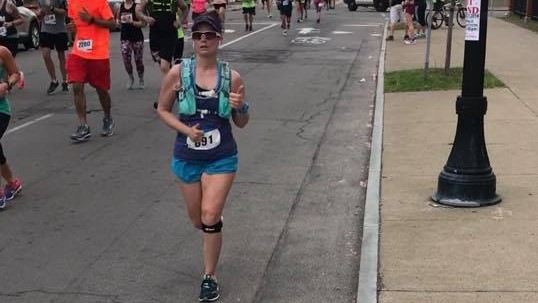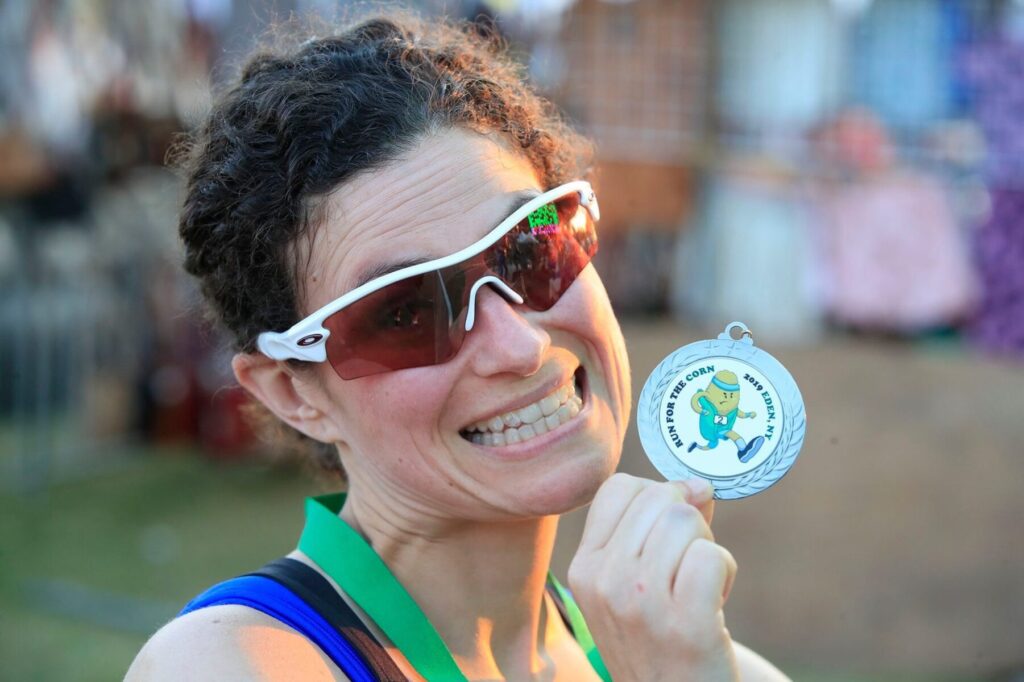I ran this weekend.
That doesn’t sound very exciting, does it? I am a running coach, after all. You probably thought I run all the time! Surprise!
I have definitely done my share of “running all the time.” I have trained for, and run, 5Ks, 10Ks, half marathons, full marathons, races of weird, inexplicable distances (like 8.7 miles…why?).
My last marathon was in spring 2018 and it was a disaster. Race day was hot and humid. I seriously considered dropping out at the halfway point. My longed-for PR remained a dream. Post-race, I took a few weeks off to rest and then started training for two back-to-back half marathons in the fall. A couple of weeks into that training, my body revolted. I was exhausted, with constant headaches that no amount of ibuprofen or acetaminophen helped. I wasn’t sleeping well. My training runs were awful.

How did I respond?
I assumed I wasn’t training hard enough. I worked harder. I ran more. I got slower. I hated running. Finally, during an evening run, I had chest and back pain on my left side. I thought I was having a heart attack. I went to the emergency room. (Want to see medical professionals move really fast? Show up on a Monday night in a quiet ER as a forty-something woman presenting with chest pains. You’ll be in a hospital bed chewing an aspirin before you know it.)
I was not having a heart attack. I was having an anxiety attack. I certainly had more than my fair share of anxiety at that time, and training was making it worse. I had a classic, textbook case of overtraining syndrome.
The American Council on Exercise defines overtraining as “constant intense training that does not provide adequate time for recovery.” That’s kind of like pointing at a lion and calling it a cat. It’s true, but it leaves out some important details.
Overtraining syndrome (OTS) occurs when one is training seriously but not paying attention to proper recovery, nutrition or sleep (or struggling with meeting those needs for some reason). Also, overtraining happens when one doesn’t take into account the stress of everyday life and responsibilities. Elite and professional athletes can certainly suffer from overtraining syndrome (sometimes called burnout). But elite athletes can focus completely on their sport. They have whole teams of people who work to remove as many responsibilities as possible from them so they can dedicate themselves fully to their performance.
Everyday amateurs like you and me? Not so much.
At my training peak, my weekday runs were 8 milers that I squeezed in during my “lunch hour” (more like 90 minutes, so I could shower and not stink up the whole office). I did shorter runs in the hour between work and dinner and longer runs on the weekends, taking time away from being with The Child. I still worked 40 hour weeks. I still had a house and family to take care of, grocery shopping and cooking to do, family and social activities to participate in. The Child broke his arm. My husband broke his ankle. There was a huge family wedding. The day-to-day responsibilities of amateur athletes mean that the everyday stressors we experience make us prime candidates for OTS. Then when our performance suffers, we think that the answer is to work harder. Do more. Put more stress on ourselves. Our performance doesn’t improve. Instead, we crash.
The goal of training is to gradually increase the load on the body to cause adaptation – we change, literally, to be able to meet the demands we place on ourselves. This process includes adequate recovery time. Then, we gradually remove load by running fewer miles as we get closer to race day (usually called tapering). On race day, when all the extra load has been removed, the body is able to overcompensate and meet the goal we’ve set. If you’re training for a marathon, you might run as many as 40 or 50 miles in one week, but on race day, you’re only going to run 26.2. The body is able to run well beyond that, because it has adapted to the gradual load increase. All you’re asking it to do is 26.2. That isn’t easy, exactly, but it’s less than what is possible.
OTS can manifest itself through a combination of physical, mental and emotional symptoms. Fatigue, mood disturbances, abnormal appetite, heaviness in the limbs, poor sleep, mysterious aches and pains and low-grade infections like colds are all common symptoms.
However, the two most important factors to consider are whether your performance is suffering despite following your training plan and whether you are still enjoying running. If you think you’re suffering from OTS, the first step is to take some time off and reevaluate. This can be extremely hard to do if you have a race coming up, but to solve OTS, you need some perspective and that means taking a step back. How much time off? A week minimum for shorter races and at least two weeks for longer races is a good start.
Use that time to see your doctor and make sure there’s no clinical reason for your symptoms. Get some rest, stay well-hydrated and nourished and take some gentle activity – walking, gentle yoga and stretching are ideal. When your training vacation is over, see how you feel. Are you revitalized and looking forward to your runs? Do you feel like your performance has improved? If so, it’s time to update your training plan to incorporate more rest and recovery time and allow you to move forward without falling back into the OTS trap. (Read this great article about overtraining syndrome.)
If not, it’s time to reevaluate your entire training plan. Maybe the plan is too advanced for your fitness level or the load increase is too steep. Maybe you need a plan that builds in more cross-training. You might need some time away from training to deal with other responsibilities in your life. Maybe you need a running coach!
For me, I needed time away from running. It had become all-encompassing for me and I wasn’t enjoying it anymore. I took a few months off and that was when I began practicing yoga, which ultimately led to my teaching certification. When I tried to start running again, it still felt forced, so I didn’t push it. I went for walks and worked in running intervals of half a mile or so. I ran the occasional 5K with friends and family and walked as much as I needed to during races. I came back to running gradually – really, I let running come back to me. Between then and now, I have run only when I have felt like it, no more than 5 miles at a time. It has become a pleasurable activity for me, rather than an obligation.

Will I run another marathon? Probably. I feel the itch now and then to run longer distances and sometimes crave the steadiness of a well-designed training program. My experience with OTS has taught me that I need a longer, more gradual program with plenty of time for rest and recovery. When the time comes, I’ll know it.
In the meantime, I can use my experience to help you. If you’re thinking of taking on a new running goal, I can help you find a training program that works for you. We’ll talk about a lot of things – your job, your family responsibilities, how and why you like to run – to make sure that we’re taking a holistic view of your training.
If you’re brand-new to running, or thinking of transitioning from walking to running, I can help you with that. I’ve been there before too. We’ll take it slow, I promise.
Thanks for being with me on this wellness journey.


Leave a Reply